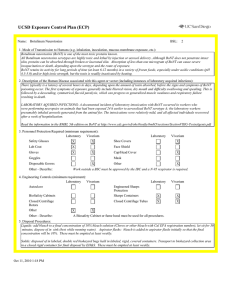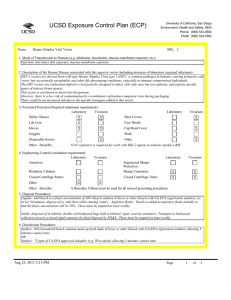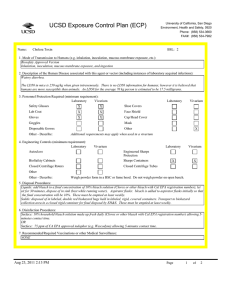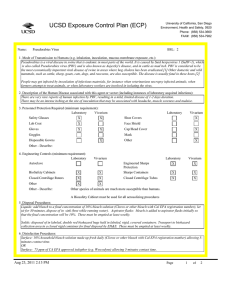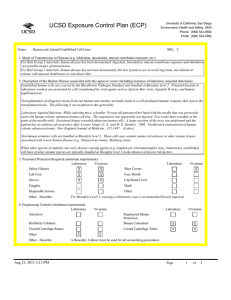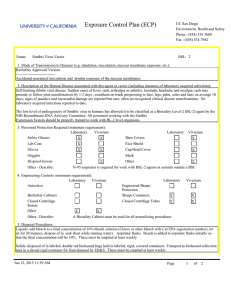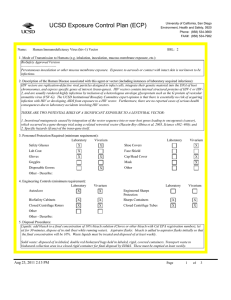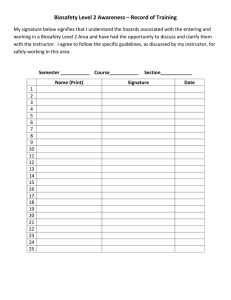UCSD Exposure Control Plan (ECP)
advertisement
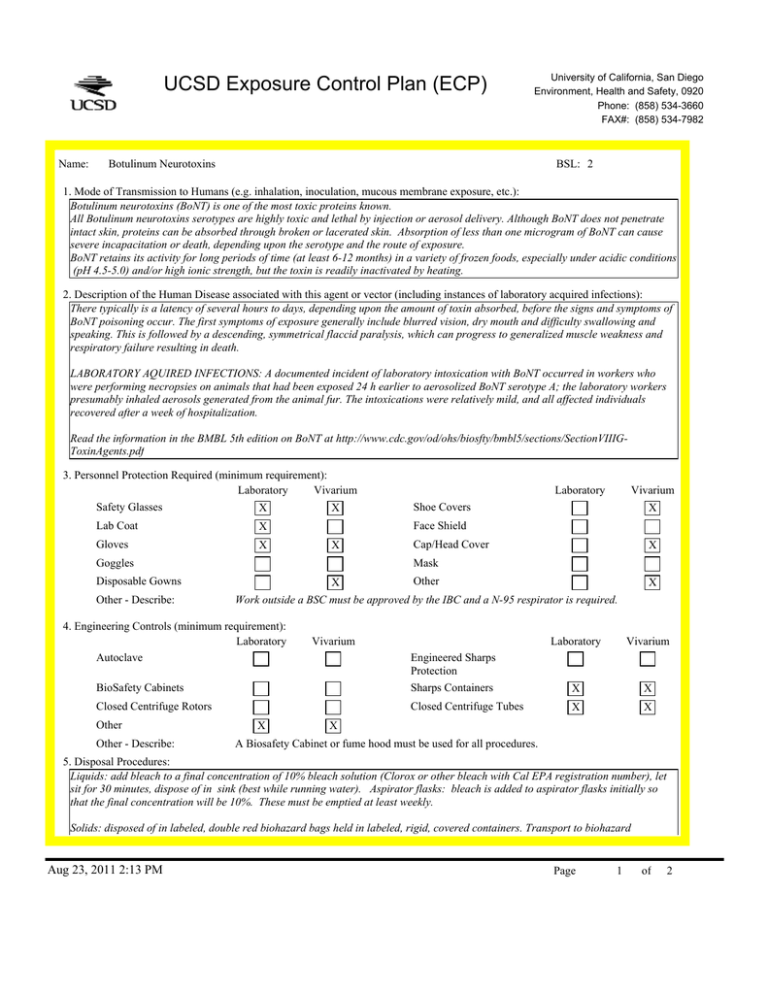
UCSD Exposure Control Plan (ECP) Name: University of California, San Diego Environment, Health and Safety, 0920 Phone: (858) 534-3660 FAX#: (858) 534-7982 Botulinum Neurotoxins BSL: 2 1. Mode of Transmission to Humans (e.g. inhalation, inoculation, mucous membrane exposure, etc.): Botulinum neurotoxins (BoNT) is one of the most toxic proteins known. All Botulinum neurotoxins serotypes are highly toxic and lethal by injection or aerosol delivery. Although BoNT does not penetrate intact skin, proteins can be absorbed through broken or lacerated skin. Absorption of less than one microgram of BoNT can cause severe incapacitation or death, depending upon the serotype and the route of exposure. BoNT retains its activity for long periods of time (at least 6-12 months) in a variety of frozen foods, especially under acidic conditions (pH 4.5-5.0) and/or high ionic strength, but the toxin is readily inactivated by heating. 2. Description of the Human Disease associated with this agent or vector (including instances of laboratory acquired infections): There typically is a latency of several hours to days, depending upon the amount of toxin absorbed, before the signs and symptoms of BoNT poisoning occur. The first symptoms of exposure generally include blurred vision, dry mouth and difficulty swallowing and speaking. This is followed by a descending, symmetrical flaccid paralysis, which can progress to generalized muscle weakness and respiratory failure resulting in death. LABORATORY AQUIRED INFECTIONS: A documented incident of laboratory intoxication with BoNT occurred in workers who were performing necropsies on animals that had been exposed 24 h earlier to aerosolized BoNT serotype A; the laboratory workers presumably inhaled aerosols generated from the animal fur. The intoxications were relatively mild, and all affected individuals recovered after a week of hospitalization. Read the information in the BMBL 5th edition on BoNT at http://www.cdc.gov/od/ohs/biosfty/bmbl5/sections/SectionVIIIGToxinAgents.pdf 3. Personnel Protection Required (minimum requirement): Laboratory Vivarium Safety Glasses X X Lab Coat X Gloves X Vivarium X Face Shield X Goggles Cap/Head Cover X Mask Disposable Gowns Other - Describe: Laboratory Shoe Covers X Other X Work outside a BSC must be approved by the IBC and a N-95 respirator is required. 4. Engineering Controls (minimum requirement): Laboratory Autoclave Laboratory Vivarium BioSafety Cabinets Engineered Sharps Protection Sharps Containers X X Closed Centrifuge Rotors Closed Centrifuge Tubes X X Other Other - Describe: X Vivarium X A Biosafety Cabinet or fume hood must be used for all procedures. 5. Disposal Procedures: Liquids: add bleach to a final concentration of 10% bleach solution (Clorox or other bleach with Cal EPA registration number), let sit for 30 minutes, dispose of in sink (best while running water). Aspirator flasks: bleach is added to aspirator flasks initially so that the final concentration will be 10%. These must be emptied at least weekly. Solids: disposed of in labeled, double red biohazard bags held in labeled, rigid, covered containers. Transport to biohazard Aug 23, 2011 2:13 PM Page 1 of 2 UCSD Exposure Control Plan (ECP) collection area in a closed rigid container for final disposal by EH&S. These must be emptied at least weekly. 6. Disinfection Procedures: Surface: 10% household bleach solution made up fresh daily (Clorox or other bleach with Cal EPA registration number) allowing 5minutes contact time. OR Surface: 75 ppm of CA EPA approved iodophor (e.g. Wescodyne) allowing 5-minutes contact time. 7. Recommended/Required Vaccinations or other Medical Surveillance: The UCSD Center for Occupational and Environmental Medicine and the Institutional Biosafety Committee (IBC) do not recommend vaccination unless a risk-benefit assessment and medical consult is completed. Research staff interested in receiving the vaccination or additional information should contact EHS/Occupational Health at 858-534-8225 to receive assessment and medical consult. Additional information about the Botulinum Toxoid Vaccine (PBT) is available on the Biosafety BLINK webpage/High Risk Biological Agents: http://blink.ucsd.edu/safety/research-lab/biosafety/medical-consultation.html 8. Employee Exposures- first aid procedures: a. Eye exposure from splash or aerosols - rinse a minimum of 15 minutes in eye wash or flush area with water. b. Skin exposure - wash area with soap and water for 15 minutes c. Needle stick and/or sharps exposure - wash wound area with soap and water for 15 minutes d. Contamination of clothing - remove the contaminated clothing and place in biohazard bag, shower with the emergency douse shower, and put on clean clothes. e. Spill or release - Monday through Friday, 8a - 4:30p call EH&S at (858-5343660); after hours call UCSD Police (858-534-4357) 9. Employee Exposure - seek medical follow-up from the following medical providers: (TAKE THIS ECP WITH YOU) 24-hour walk-in service: Thornton Hospital Emergency Room (858) 657-7600 UCSD Medical Center (Hillcrest) Emergency Room (619) 543-6400 Call the Center for Occupational & Environmental Medicine (COEM) at (619) 471-9210 to determine if a follow up visit with COEM is required. Most exposures will require a visit to COEM. Monday - Friday, 8a - 4:30p 10. Report All Injuries, Illnesses, and Exposures to EH&S: Complete the information found on "What to Do if a Work-Related Injury or Illness Occurs" (http://blink.ucsd.edu/Blink/External/ Topics/How_To/0,1260,4295,00.html) 11. Required Biosafety Training: Laboratory specific training on hazards, exposure evaluations, and the required precautions for experimental procedures used with this agent - provided by Principal Investigator. 12. Lab specific instructions: Procedure listed in protocol S03102. Proper safety precautions include the use of lates gloves, googles or face shield, lab coat is used when moving animal. Administration of this agent is to be performed by research staff. The preparation of this agent is done in a chemical fume hood. Aug 23, 2011 2:13 PM Page 2 of 2
